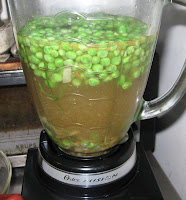There are lots of variations, but usually it's a protein and some vegetables, including onion of some sort, mixed with beaten egg and served with a sweet sauce made of stock, soy sauce and a sweetener.
I, because I was feeling too lazy to defrost a chunk of meat, went with tofu as my main ingredient. I used firm tofu, cut into blocks about an inch square by two inches and deep-fried for about a couple minutes longer than you usually want to. Usually, when you're frying tofu, you're just getting it a little golden and crisp around the edges. If you cook it longer, the golden layer thickens and the tofu gets dried out and chewy. In this case, that's a good thing. The tofu firms up as it cools so it was still soft enough that I was able to squeeze out the absorbed oil with my tongs as I pulled it out of the pan.
I also dug up a few scraps of sirloin I had in the back of the refrigerator; sliced them thin; marinated in soy sauce, white pepper and sesame oil; shook them dry and gave them a quick dip in cooking oil. Just enough to brown since they're getting cooked a little more later.

Next, in a small pot, I combined 1 cup mushroom stock, 2 Tablespoons soy sauce and 1 1/2 Tablespoons sugar and brought it to a boil. I added the tofu and mushrooms, turned down the heat and simmered for 5 minutes to let them absorb the sauce's flavors. And just absorb the sauce, I suppose.
Meanwhile,
 I beat a couple eggs and mixed in a large scallion, sliced into 2-inch lengths and the beef I half-cooked earlier. After the 5 minutes were up, I turned the heat up a little and added the egg mixture. Once I saw that the egg had started to solidify, I turned the heat back down, covered the pot and let it simmer for 3 minutes more.
I beat a couple eggs and mixed in a large scallion, sliced into 2-inch lengths and the beef I half-cooked earlier. After the 5 minutes were up, I turned the heat up a little and added the egg mixture. Once I saw that the egg had started to solidify, I turned the heat back down, covered the pot and let it simmer for 3 minutes more.After that, I just dumped half over a big bowl of rice and served (and saved the rest for later). But what I should have done was to fish out the solids and then thicken the sauce with a little corn starch. That would have disguised the ugliness of this bowl a little bit.

Appearances aside, it tastes great. The sauce is a balance of savory and sweet that's a bit intense on its own, but just right absorbed into a whole lot of rice. The simmering has softened the tofu from leathery to a pleasantly meaty chew. The sauce's flavors penetrated through the outer layers, but left a creamy plainer tofu center. The mushrooms, on the other hand, soaked up the sauce and give off bursts of flavor at the bite. And the rest add some nice flavors and textures without being worth noting in detail.
It should make a good weekday meal since it's so quick and easy. Here's a more generalized recipe:
Ingredients:
1/2 pound of firm tofu, cut into largish chunks
a little meat or fish, cut into strips [or ditch the tofu and add more meat if you like]
4 small dried shiitake mushrooms, soaked and quartered
1 large or 2 small scallions, both white and green parts or a white onion, cut into 1-2" lengths
some broccoli, fresh mushrooms, greens or daikon wouldn't be a bad addition. Just add heartier stuff early and more delicate ingredients late
1 cup stock or dashi
2 Tablespoons soy sauce
1 1/2 Tablespoons sugar or mirin
maybe a couple teaspoons sake
2 large eggs, beaten lightly
lots of white rice
0. Start cooking the rice.
1. Deep or pan fry the tofu until golden brown and crispy. Par-cook the meat.
2. Mix sauce ingredients and bring to a boil. Add tofu and dried or tough vegetables. Simmer 5 minutes.
3. Mix egg with meat, delicate vegetables and onion. Add to pot. Cover and simmer 3 minutes more.
4. Remove solids from pot and divvy up amongst two or three bowls of rice. Measure 2 teaspoons cornstarch into a small bowl. Add a small ladle of the sauce and mix well. Pour back into pot and simmer until thickened slightly. Top the rice bowls, add a sprinkling of sesame seeds to garnish and serve.














































